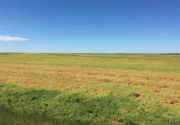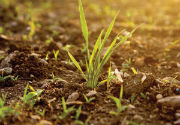| |
| |
 |
| |
 |
|
MMMM d, yyyy |
|
| |
 Almost 800,000 honeybee colonies are in active duty on Canadian farms this year. That’s about 10 per cent more than in 2016, which was another record year. In fact, the number of hives has been climbing since the late 1990s.
» Read more...
Almost 800,000 honeybee colonies are in active duty on Canadian farms this year. That’s about 10 per cent more than in 2016, which was another record year. In fact, the number of hives has been climbing since the late 1990s.
» Read more...
Ontario farmers: If you include winter wheat in your crop rotation (whether or not you currently include red clover), you are invited to participate in an online survey regarding your experience with, and management of, red clover in your crop rotation.
» Read more...
For various reasons, countries around the world are searching for renewable replacements for petroleum. One promising alternative comes from the seed oils of plants.
» Read more...
|
| |
 |
| |
|
| |
 Root rots are caused by a complex of pathogens. In Alberta pea fields, Pythium species and Rhizoctonia solani were present in many fields. Fusarium was the largest group found on pea roots. In Alberta, F. avenaceum and F. solani are the two major players. These species are more virulent on peas than some of the other Fusarium species.
» Read more...
Root rots are caused by a complex of pathogens. In Alberta pea fields, Pythium species and Rhizoctonia solani were present in many fields. Fusarium was the largest group found on pea roots. In Alberta, F. avenaceum and F. solani are the two major players. These species are more virulent on peas than some of the other Fusarium species.
» Read more... |
| |
 In early growth, dry conditions can limit the number of tillers or the potential number of grains that can be produced. In mid-season, at flowering, dry conditions can limit anthesis and lead to empty florets that could have become grain. Later stress can limit production of the photosynthates that go into the grain. If that happens, you have lighter seed that isn’t plump enough for a milling grade.
» Read more...
In early growth, dry conditions can limit the number of tillers or the potential number of grains that can be produced. In mid-season, at flowering, dry conditions can limit anthesis and lead to empty florets that could have become grain. Later stress can limit production of the photosynthates that go into the grain. If that happens, you have lighter seed that isn’t plump enough for a milling grade.
» Read more... |
| |
|
| |
|
|
| |
| |





